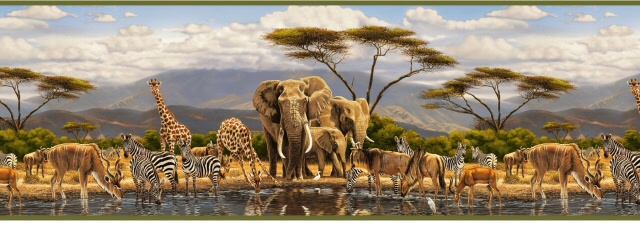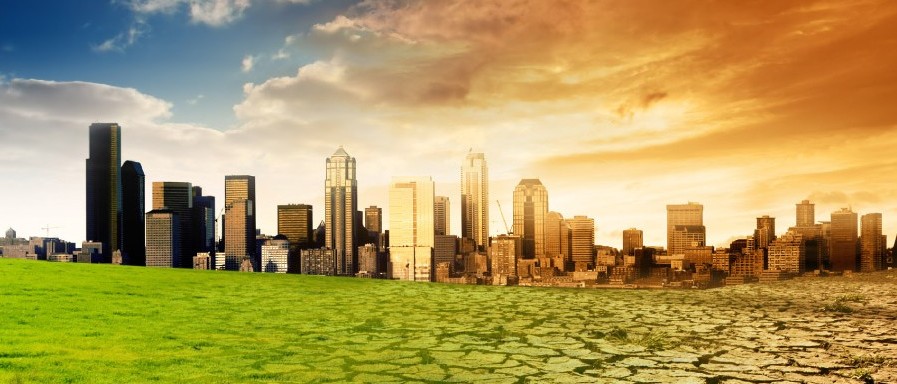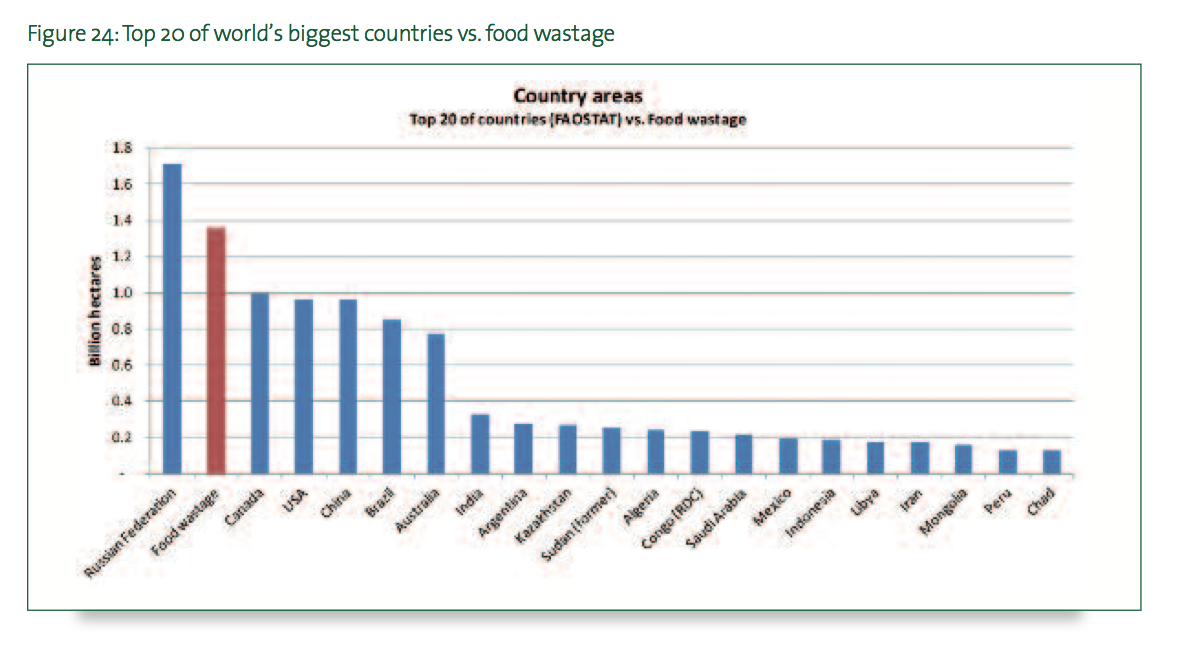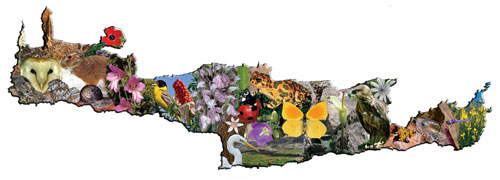
Ecological impacts affect all living things on Earth by altering the natural systems that enable their existence, including you and I. These impacts can be considered as most severe, as once these changes happen to our environment, they are mostly irreversible. 4 factors have been identified that directly suffer due to food wastage, and they are discussed below.
1. Climate

Carbon dioxide and greenhouse gases act like blankets that trap heat within the Earth’s atmosphere, keeping it warm. While moderate levels of such gases are necessary for life on Earth, these levels have been steadily increasing over the past few decades. As a result, the Earth overheats, resulting in the phenomenon known as Global Warming, which brings along a whole range of devastating impacts.
To calculate the effect of food wastage on climate, carbon footprint – “the total amount of greenhouse gases (i.e. methane and nitrous oxides) emitted by a product throughout its life cycle and expressed in kilograms of carbon dioxide equivalents” – is calculated. This may be produced from the production phase through farming, soils and livestock, right though till the decomposition phase of wasted food products.

According the Food and Agriculture Organization of the United Nations (FAO), the global carbon footprint (excluding land use change) has reached an estimated 3.3 billion tonnes of carbon dioxide equivalent in 2007. The figure above puts things into perspective, where food wastage will come in third when compared with the greenhouse gas emission levels of countries around the world. This finding suggests that throwing excess food is not as innocent as it seems, and can affect life on a global scale.
2. Water

In relation to food wastage, water consumption is focused on rather than withdrawal. Consumptive water use refers to water that is no longer “physically available in the immediate environment (i.e. oceans, lakes, reservoirs, etc.) as it has been”; for example, water consumed by people or animals, transpired by plants, or used in the manufacturing process of products. The water footprint, which considers the “total volume of fresh water that is used directly or indirectly to produce a product”, is used to determine the extent to which food wastage affects our limited freshwater supply on Earth; specifically, blue water in agriculture, which refers to the “consumptive use of irrigation water taken from ground or surface water”, is calculated.

FAO revealed that 92% of the water footprint of humanity is derived from the consumption of agricultural products, emphasising the significance of agriculture and its impact on the global water footprint. As seen in the figure above, the global blue water footprint of food wastage for agricultural production in 20 is the higher than any country in the world at about 250km3 – enough to fill MacRitchie Reservoir almost 60,000 times!
Out of the total amount of water consumed globally, about 12 to 15% is used to produce uneaten food, either via the irrigation of crops, or late in the food supply chain through processing and distribution. The Commonwealth Scientific and Industrial Research Organisation (CSIRO) also found that throwing out a kilogram of potatoes wastes about 500 litres of water, while throwing out the same amount of white rice wastes about 1550 litres of of water!
All of these findings suggest that wastage of agricultural food products (i.e cereal, rice, noodles) depletes our already finite source of freshwater, as it takes a lot of water to produce and process crops before they are safe for human consumption. With lesser freshwater sources available in the world, the sustainability of life on Earth will adversely be impacted.
3. Land

As seen in the picture on the beginning of the “Impacts” page, a lot of food wasted goes straight to landfills to create mountains of food waste. In the United States of America, food and other organic waste products make up the second largest component in their landfills, and is the largest source of methane emission.
Wasted food also affects land indirectly by taking up space to produce these food products. To calculate the impact of food waste on land, we use the term land occupation, which refers to the “surface of land, including cropland and grassland, that is necessary to produce foodstuff; more specifically, it evaluates the surface used to produce food that does not get eaten due to wastage”.

Between 20 to 30% of cropland around the world is dedicated to growing food that is wasted. From the graph above, food wastage in 2007 accounts for the second largest land area in the world, just slightly behind the Russian Federation. This means that the amount of food produced and not eaten can fill up about 1.4 billion hectares of land! Furthermore, land is a finite resource as the use of land for one purpose (i.e. agriculture) will prevent it from being used for other competing purposes (i.e. buildings, roads, etc.).
The negative impact of food wastage on land use is evident; not only are we wasting precious green spaces, we pollute our lands by discarding food that will decompose and pollute the soils. We also discount ourselves from the use of land that can be developed into more useful spaces, as development will often steer clear from landfill due to the fear of catching any infections diseases, as well as the lack of aesthetic appeal.
4. Biodiversity

The threat to biodiversity is perhaps the least obvious impact that is commonly overlooked by people when they throw excess food into the bin. Biodiversity includes all life on Earth, across genes, species and ecosystems.
In order to produce land that can be used for agriculture, large expanse of forests get deforested, stripping many animals off their natural habitat, while killing off some others in the process. This is more prominent in the tropics, where the climate is more favourable for agricultural practices. However, the tropical forests are also homes to the most number of animal and plant species, thus creating a conflict between growing food crops and protecting biodiversity. With food getting wasted, many species would have been diminished for nothing as the crops produced from the land cleared gets thrown away.
Food wastage also affects biodiversity due to animal husbandry, which involves the breeding and caring of livestock. Uncontrolled and intensive grazing of farm animals has been found to negatively correlate to a natural habitat’s ecological value. Furthermore, food fed to these animals often come from excess crop yield that fail human food safety requirements. As a result, some of these animals may consume food that lack proper nutrients for growth, and become malnourished due to the lack of nutritional value in their diet.
Threats to biodiversity have been found to be higher in developing countries that developed countries. Approximately 72% of species are threatened due to crop production in the developing countries, as compared to 44% in the latter countries. Livestock production pose as a lower threat as compared to crop production, with 21% of species threats deriving from developed countries, and 34% in developing countries.
Among all species of life, birds face the highest threat from food wastage. One possible reason could be due their ability to fly and forage among landfills that contain food waste, which are commonly already undergoing decomposition. As a result, birds die from consuming these spoilt food items.
For more information on how food wastage affects ecology, check out FAO’s Summary Report on the footprint of Food Wastage.
Be First to Comment